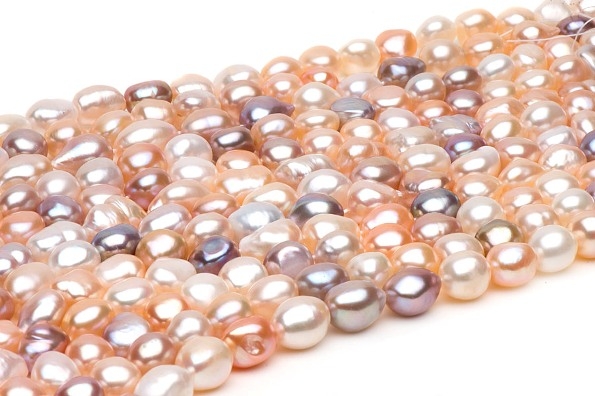As the name suggests it, freshwater pearls are the only type of pearls that grow in fresh waters. They are also the most diverse pearls as you can find them in many sizes, shapes, and colors. But which freshwater pearls are right for you? When buying these semi precious gemstones, what should you look for? Read further to discover the answers to these questions and learn everything you need to know before buying freshwater pearl jewelry.
How do freshwater pearls grow?
You probably know the difference between cultured and wild pearls from our previous articles, but, for those of you who are new to Ana Luisa’s universe, we are going to make a quick recap. The only difference between cultured and wild pearls is where they grow. There is no other difference. Both types are natural, come from oysters and have the same properties. Wild pearls grow in oysters that live in the ocean, while cultured pearls grow inside oysters in special farms.
As you know, the pearl inside the oyster is the result of an irritant, usually a shell piece. When it enters the oyster, this irritant prompts it to protect itself by secreting a substance that hardness into a pearl. Most of the oysters in the oceans live their lives happily ever after without encountering any irritant. That’s why wild pearls are an accident and, as a result, very rare. When it comes to the oysters in special farms, people surgically insert the irritant to control the pearl creation process.
Coming back to freshwater pearls, they are the only type that grows in fresh waters in mussels. The other types of cultured pearls (Akoya, Tahitian & South Sea) grow in saltwater. As opposed to the saltwater types where the irritant is a shell piece, in freshwater pearls, the irritant is composed of 24 to 32 microscopic mantle tissue pieces. For the next 2 to 7 years, the mussel will deposit layers of nacre and, in the end, produce approximately two dozen freshwater pearls.
How are freshwater pearls different from saltwater ones?
Besides the growing and farming process, freshwater pearls also present other differences when compared to saltwater pearls. First of all, they are rarely perfectly round. Usually, freshwater pearls are freeform or baroque. Secondly, they come in a greater diversity of colors than any other pearl type. And last, but not least, their luster is different from saltwater pearls. Instead of the glossy, mirror-like finish, their luster is warmer and offers a soft glow.
Freshwater pearls properties
Before buying freshwater pearls, you need to know a couple of things about their sizes, colors, shape, and value. Just read further to understand what to look for when buying freshwater pearls.
Their size
Usually larger than Akoya pearls and smaller than South Sea & Tahitian pearls, the freshwater variety has the widest size range. You can find freshwater pearls with sizes ranging from 2 to 15 mm. Just for you to get an idea, Akoya pearls can be between 5 to 10 mm, Tahitian ones between 8 and 21 mm, while South Sea pearls have sizes ranging from 8 to 20 mm.
Their color
Besides producing the widest array of sizes, freshwater pearls also have the widest range of colors. They can be lavender, white, peach (or even black when dyed) and have overtones like pink, aquamarine, green, ivory, silver, and rose. Because of their wide range of colors, freshwater pearls are ideal for crafting multi-colored pearl necklaces.
Their shape
As we said in the beginning, freshwater pearls come in many shapes, but they are rarely perfectly round. They can be rice-shaped, button, drop, coin-shaped, off-round as well as oval, baroque or simply freeform. However, if you are looking for round freshwater pearls, know that you can find them, but expect to pay more for this type.
Their value
Freshwater pearls have a grading system that determines their value. According to this system, you can buy pearls that are:
- A-AAA quality. This means that the pearls are near perfectly round, with excellent luster and a blemish rate between 0 to 5%. 0.03% of the freshwater pearls each year receive this grade.
- AAA quality. These pearls are mostly round, feature a satin luster and present blemishes of 5% of the surface of each pearl. 1% if the freshwater pearls each year receive this grade.
- AA+ quality. With 5% of pearl harvest each year receiving this grade, these pearls are slightly off-round, have good luster and 5 to 10% blemishes.
- AA quality. The pearls in this category represent 10% of the harvest each year, feature a fair luster with some blurring around the edges and present less than 20% blemishes.
- A quality. These are the most common freshwater pearls harvested each year. They don’t have a powerful luster, but rather a subtle glow. They can be any form but, in order to be accepted, they need to present less than 50% blemishes.
If you enjoyed reading this article, check out what else we have in store for you. Visit Ana Luisa online jewelry shop to discover our fabulous pearl earrings collections.

Others interesting posts about this topic :
- 4 Evil Eye Jewelry Pieces that You Need to Have
- What is Mother of Pearl Jewelry?
- How to rock cubic zirconia jewelry
- How to Buy Nickel Free Jewelry?
- 4 Things You Need to Know About Fine Sterling Silver Jewelry
- How to Buy Fine Gold Jewelry Depending on Your Needs
- Best Types of Jewelry this Season
- Where to Find the Best Jewelry Sale?
- Our Favorite Freshwater Pearls Jewelry by Ana Luisa
- How to Buy Agate Jewelry
- How to Check the Diamond Quality
- Top 6 Essential Jewelry Pieces for Any Woman
- Discover Our Top Picks for Capricorn Jewelry
- Sagittarius Jewelry Pieces That You Can’t Wait to Try On
- Scorpio Jewelry Pieces that We Love
- Focus on Leo Jewelry – What Are the Right Pieces for You?
- Best Cancer Jewelry Pieces That You Need to Have
- Taurus Jewelry – Which Pieces Define Your Style?
- Aries Jewelry – Discover the Designs that Represent Your Astrological Sign
- Top Pisces Jewelry Designs that You Will Love
- Focus on Aquarius Jewelry – What Should You Get?
- Trending this Season: Zodiac Jewelry
- Trending 14k Gold Jewelry This Season
- Travel Jewelry – The Best Travel Inspired Designs
- Mothers Day Gift Ideas This Year
- Top Ideas for Mothers Day Jewelry
- Our Top Favorite Pink Gemstones
- How to Buy Black Pearls
- Freshwater Pearls vs. The Saltwater Varieties
- What Jewelry to Offer as a Valentines Day Gift
- Ana Luisa’s Most Popular Jewelry
- Our Top Picks for January Jewelry
- What Is Coin Jewelry?
- Valentines Jewelry: Top Gift Ideas
- Most Important Jewelry Trends this Year
- What Gemstone Jewelry Should Your Wear in 2019?
- Jewelry Gift Boxes Ideas for Christmas
- What Makes a Good Jewelry Gift Box?
- How to Find Jewelry Coupon Codes: Mejuri Coupon Code & Others
- Ana Luisa’s Top of the Best Colorless & White Gemstones
- Top Fabulous Red Gemstones
- Everything You Need to Know about Gold Vermeil Jewelry
- Tourmaline Jewelry Buying Guide
- What is ethnic jewelry?
- Topaz Jewelry Buying Guide
- Our Favorite Simple Jewelry Pieces Any Woman Should Have
- How to Buy Lapis Lazuli Jewelry
- Which Are the Best Jewelry Metals for Your Style?
- 14k Gold VS 18k Gold – Which Should You Get?
- Timeless Jewelry Pieces That You Need to Have
- What Is Hypoallergenic Jewelry?
- Top Interesting Cultural Jewelry Pieces
- Garnet Jewelry Buying Guide
- What Is the Winter Jewelry You Need to Have This Season?
- How to Buy Rose Quartz Jewelry
- 5 Reason Why a Jewelry Gift Card is a Great Idea
- How to Buy Malachite Jewelry
- Top Tips When You Buy Jewelry Online
- Top Christmas Jewelry Present Ideas
- What To Avoid When Buying Black Friday Jewelry?
- Birthday Jewelry Guide
- How To Start Your Jewelry Collection
- How To Pick Personalized Jewelry
- How To Buy Opal Jewelry
- Everything You Need To Know About Rhodium Plating
- White Gold Jewelry, Rose Gold and Yellow Gold – Which One Is Right for You?
- What Is Ancient Greek Jewelry and How to Buy It?
- What Is Byzantine Jewelry and Why Should You Have Some?
- How many gold colors are there?
- How to buy Akoya pearls
- How to buy South Sea Pearls
- How to buy Tahitian Pearls
- What to look for when choosing a jewelry box
- What are chocolate diamonds?
- How to buy Moonstone jewelry
- How to buy jade jewelry
- How to spot fake pearls
- What to do if you have a nickel allergy?
- What is Inlay Jewelry?
- Should you buy 10k gold jewelry?
- Top tips when buying amethyst jewelry
- What are the different diamond cuts?
- Top 10 gems used for semi precious stones jewelry
- What is estate jewelry?
- What is art deco jewelry?
- How can you tell if your antique jewelry is worth a lot?
- 7 of the World’s Rarest Gemstones & their value
- Enamel jewelry buying guide
- Discover the most expensive gems in the world
- Top Mom Jewelry Gift Ideas
- Zircon vs cubic zirconia – What is the difference?
- Metal Rings Buying Guide
- White Gold vs Platinum – Do You Know the Difference?
- Silver vs Sterling Silver – What is the difference?
- Rose Gold Jewelry Buying Guide
- Gold dipped jewelry – The difference between vermeil & gold plating
- Gold Plated vs Gold Filled Jewelry: What Is the Difference?
- What you should know about gold plated jewelry

